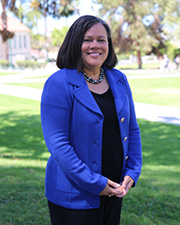Questioning the Calculations |
College Promise Programs | Donate! 


What’s AHEAD on college affordability: Voices from the field
Institutions Must Begin the Work of Cost Transparency
 Dr. Robert Alexander
Dr. Robert Alexander
Vice President for Enrollment and Communications
Millsaps College
As the chief enrollment officer of Millsaps College, the cost of college is a daily discussion I have with prospective students and their parents. Understandably, families are confused about whether the cost of an education at institutions like Millsaps College—a private liberal arts college located in Mississippi, the poorest state in the nation—is something they can afford, or whether they should expect college to be affordable (or potentially free) based on family income or their academic or athletic achievements.
Higher education’s current pricing models are confusing and lack transparency about who is paying for what proportion of costs. Each year, students comparing their college options share cost calculator results and award letters from many institutions—frankly, some are confusing to the point of apparent intentional obfuscation of true net cost.
Only by understanding the data and pushing for transparency at our own institutions can higher education professionals begin to address the problem of cost confusion. We must work to help families understand how much of their true educational costs are covered by federal, state, and institutional funds, and how much we expect them to contribute, including through federal student loan programs.
I will use these data to inform the conversations and decisions on my campus as our college tries to identify strategies that meet our institutional goals and serve our students, 30 percent of whom are Pell Grant recipients.
The Costs of College Crisis Must Focus on the Black Student Debt Crisis
 Dr. Jalil Mustaffa Bishop
Dr. Jalil Mustaffa Bishop
Vice-Provost Postdoctoral Scholar
University of Pennsylvania Graduate School of Education
When it comes to the cost of college, data and outcomes make it evident that our country has a Black student debt crisis. Black people face significantly more student loan repayment struggles—across all institution types and degree levels—than their white counterparts. This debt impacts both students and their parents who borrow to support their children, as well as their communities where the debt and its consequences become concentrated. This crisis forms at the nexus of our nation’s history, educational access, and labor market access, which operate through race, class, and gender power dynamics.
Higher education advocates have documented the different outcomes for Black borrowers through statistics, but the power dynamics behind the numbers remain understudied. My emerging research provides historical context and critical theories of race to understand the perpetual use of racialized debt in the United States. This work situates student loans in both historical and ongoing policy context, which conflate access to debt with opportunity and justice for Black people. I am launching the National Qualitative Black Student Loan study to examine the impact of debt across different life points, identities, institutions, credentials, and employment for Black borrowers.
It is not enough to document inequality in student loans, we must research how inequality is created and sustained through power. The higher education system is in question, as is society as a whole.
Colleges Can Reset Price and Cost
 Dr. Laura Casamento
Dr. Laura Casamento
President
Utica College
Nearly half of all families report eliminating a college based on cost before applying–suggesting that families judge costs by the published price and not the net cost after institutional grants or scholarship aid. In order to attract prospective students, colleges must radically address both the price and costs of their institutions.
Utica College, while reaching record total enrollments and record freshman classes in 2015, had a discount rate that had reached an unsustainable level: Net tuition revenue was stagnant despite increasing enrollments; the average student loan debt was considerably higher than peer and competitive universities; and prospective students from all income levels were beginning to withdraw Utica from consideration. The tuition price had reached a level that they were unable or unwilling to consider.
In Fall 2015, Utica College took action and announced a 42 percent decrease in the “sticker” price (tuition and fees) and lowered the average room and board price by 13 percent, putting the total published price before financial aid at $30,000 (and more than 95 percent students receive some form of financial aid).
Resetting the tuition price provided real cost savings for families of all means. Having reduced our student average debt by one-third since 2016, we are now proudly at the center of a national conversation on college affordability, access, and opportunity. Colleges and universities must consider these reforms for institutional sustainability and student affordability.
Changing Demographics Mean Colleges Changing How Dollars Are Spent
 Dr. Linda Oubré
Dr. Linda Oubré
President
Whittier College
For many students at Whittier College, a small, private Minority Serving Institution in Southern California, the difference between completing their degree—or not—can be a financial gap of a few thousand dollars.
The demographics of the United States are changing. (And in Southern California, demographic changes are already here.) Educating new types of students is expensive for institutions, and the cost of that education can be a financial, life-long burden for students.
In order to meet the affordability crisis head-on, Whittier College is focused on equity and inclusion, looking for sources of new revenue, and ensuring that the resources we use are aligned with our mission. We treat every dollar we spend as if it comes directly from students’ future loan payments.
As a first generation college student, I remember all too well my graduate school days, counting the loose coins from a jar and rolling pennies to buy groceries. But, I also remember the massive amounts my college spent on catered events and fresh flowers. The answer to college affordability is complex, but it doesn’t include catered shrimp at every campus event.


